NIT2201 - IT Profession & Ethics: Analytical Essay on Online Privacy
VerifiedAdded on 2022/12/29
|6
|1964
|99
Essay
AI Summary
This analytical essay examines the multifaceted issue of online privacy, emphasizing its significance in the digital era. It begins by defining digital privacy and its components, including information, communication, and individual privacy, and highlights the importance of safeguarding these aspects against privacy risks and attacks. The essay then delves into the legal framework, specifically referencing the Australian Privacy Act of 1988 and its thirteen privacy principles. It discusses various privacy concerns, such as unauthorized data breaches, surveillance, malware attacks, and the impact of social media platforms on data acquisition and marketing practices. The essay proposes technical and logical privacy controls, including antimalware tools and blockchain technology, and emphasizes the importance of user awareness, authentication measures, and encryption. It also addresses the need for enhanced legislation, such as the GDPR in the EU, and the development of digital privacy as a fundamental right globally. The essay concludes by stressing the importance of user awareness and responsible online behavior to protect personal information and privacy.
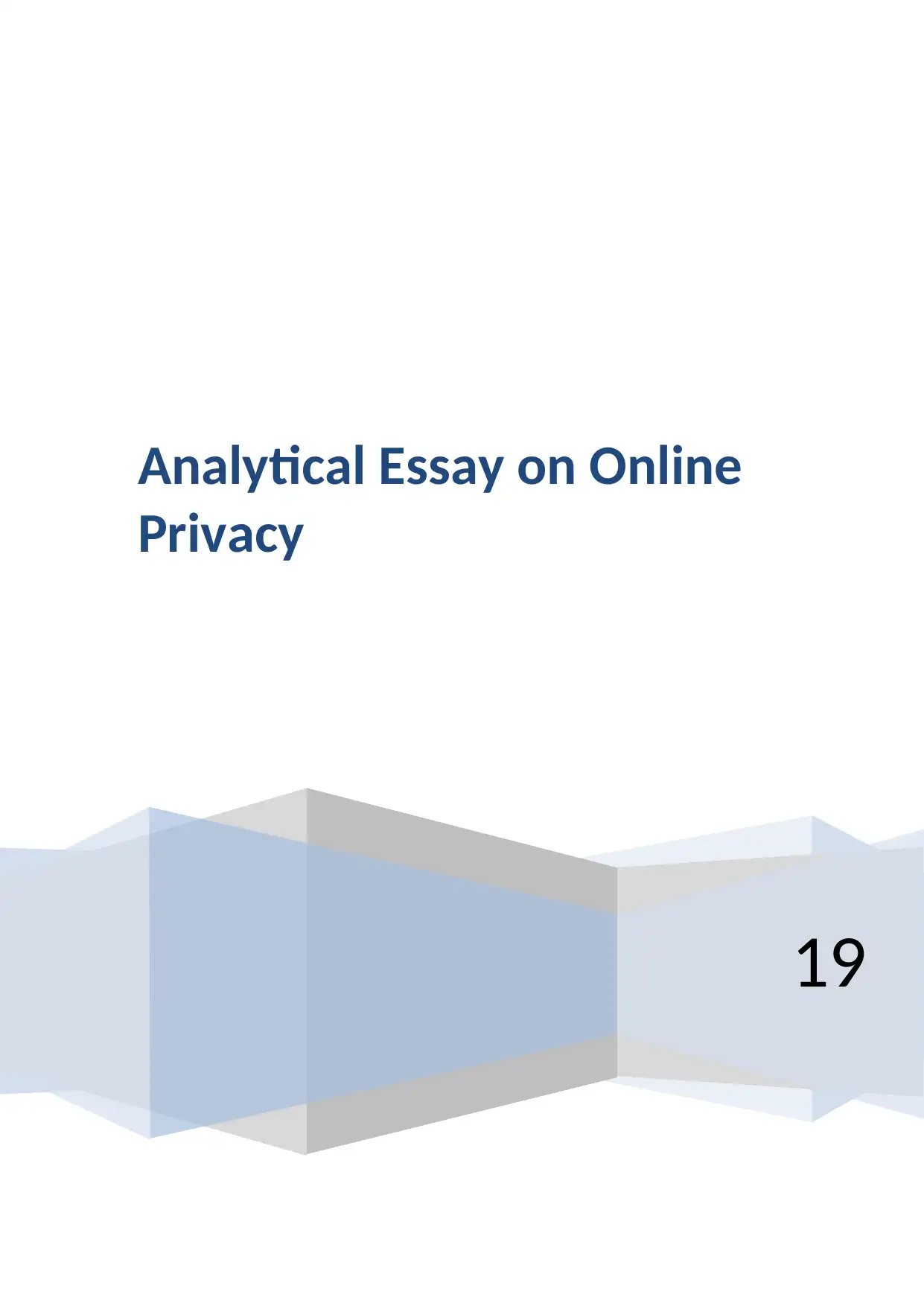
19
Analytical Essay on Online
Privacy
Analytical Essay on Online
Privacy
Paraphrase This Document
Need a fresh take? Get an instant paraphrase of this document with our AI Paraphraser
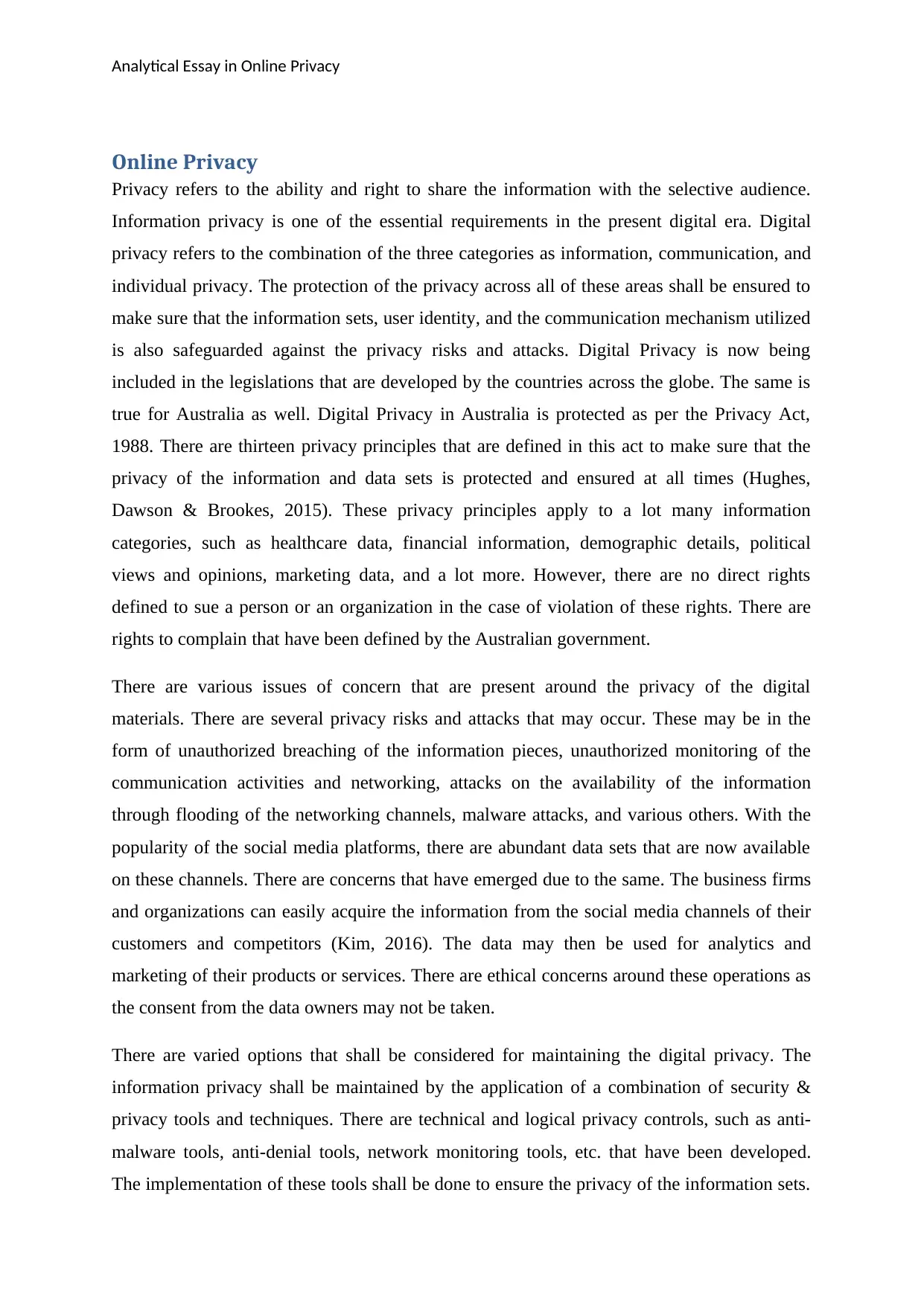
Analytical Essay in Online Privacy
Online Privacy
Privacy refers to the ability and right to share the information with the selective audience.
Information privacy is one of the essential requirements in the present digital era. Digital
privacy refers to the combination of the three categories as information, communication, and
individual privacy. The protection of the privacy across all of these areas shall be ensured to
make sure that the information sets, user identity, and the communication mechanism utilized
is also safeguarded against the privacy risks and attacks. Digital Privacy is now being
included in the legislations that are developed by the countries across the globe. The same is
true for Australia as well. Digital Privacy in Australia is protected as per the Privacy Act,
1988. There are thirteen privacy principles that are defined in this act to make sure that the
privacy of the information and data sets is protected and ensured at all times (Hughes,
Dawson & Brookes, 2015). These privacy principles apply to a lot many information
categories, such as healthcare data, financial information, demographic details, political
views and opinions, marketing data, and a lot more. However, there are no direct rights
defined to sue a person or an organization in the case of violation of these rights. There are
rights to complain that have been defined by the Australian government.
There are various issues of concern that are present around the privacy of the digital
materials. There are several privacy risks and attacks that may occur. These may be in the
form of unauthorized breaching of the information pieces, unauthorized monitoring of the
communication activities and networking, attacks on the availability of the information
through flooding of the networking channels, malware attacks, and various others. With the
popularity of the social media platforms, there are abundant data sets that are now available
on these channels. There are concerns that have emerged due to the same. The business firms
and organizations can easily acquire the information from the social media channels of their
customers and competitors (Kim, 2016). The data may then be used for analytics and
marketing of their products or services. There are ethical concerns around these operations as
the consent from the data owners may not be taken.
There are varied options that shall be considered for maintaining the digital privacy. The
information privacy shall be maintained by the application of a combination of security &
privacy tools and techniques. There are technical and logical privacy controls, such as anti-
malware tools, anti-denial tools, network monitoring tools, etc. that have been developed.
The implementation of these tools shall be done to ensure the privacy of the information sets.
Online Privacy
Privacy refers to the ability and right to share the information with the selective audience.
Information privacy is one of the essential requirements in the present digital era. Digital
privacy refers to the combination of the three categories as information, communication, and
individual privacy. The protection of the privacy across all of these areas shall be ensured to
make sure that the information sets, user identity, and the communication mechanism utilized
is also safeguarded against the privacy risks and attacks. Digital Privacy is now being
included in the legislations that are developed by the countries across the globe. The same is
true for Australia as well. Digital Privacy in Australia is protected as per the Privacy Act,
1988. There are thirteen privacy principles that are defined in this act to make sure that the
privacy of the information and data sets is protected and ensured at all times (Hughes,
Dawson & Brookes, 2015). These privacy principles apply to a lot many information
categories, such as healthcare data, financial information, demographic details, political
views and opinions, marketing data, and a lot more. However, there are no direct rights
defined to sue a person or an organization in the case of violation of these rights. There are
rights to complain that have been defined by the Australian government.
There are various issues of concern that are present around the privacy of the digital
materials. There are several privacy risks and attacks that may occur. These may be in the
form of unauthorized breaching of the information pieces, unauthorized monitoring of the
communication activities and networking, attacks on the availability of the information
through flooding of the networking channels, malware attacks, and various others. With the
popularity of the social media platforms, there are abundant data sets that are now available
on these channels. There are concerns that have emerged due to the same. The business firms
and organizations can easily acquire the information from the social media channels of their
customers and competitors (Kim, 2016). The data may then be used for analytics and
marketing of their products or services. There are ethical concerns around these operations as
the consent from the data owners may not be taken.
There are varied options that shall be considered for maintaining the digital privacy. The
information privacy shall be maintained by the application of a combination of security &
privacy tools and techniques. There are technical and logical privacy controls, such as anti-
malware tools, anti-denial tools, network monitoring tools, etc. that have been developed.
The implementation of these tools shall be done to ensure the privacy of the information sets.
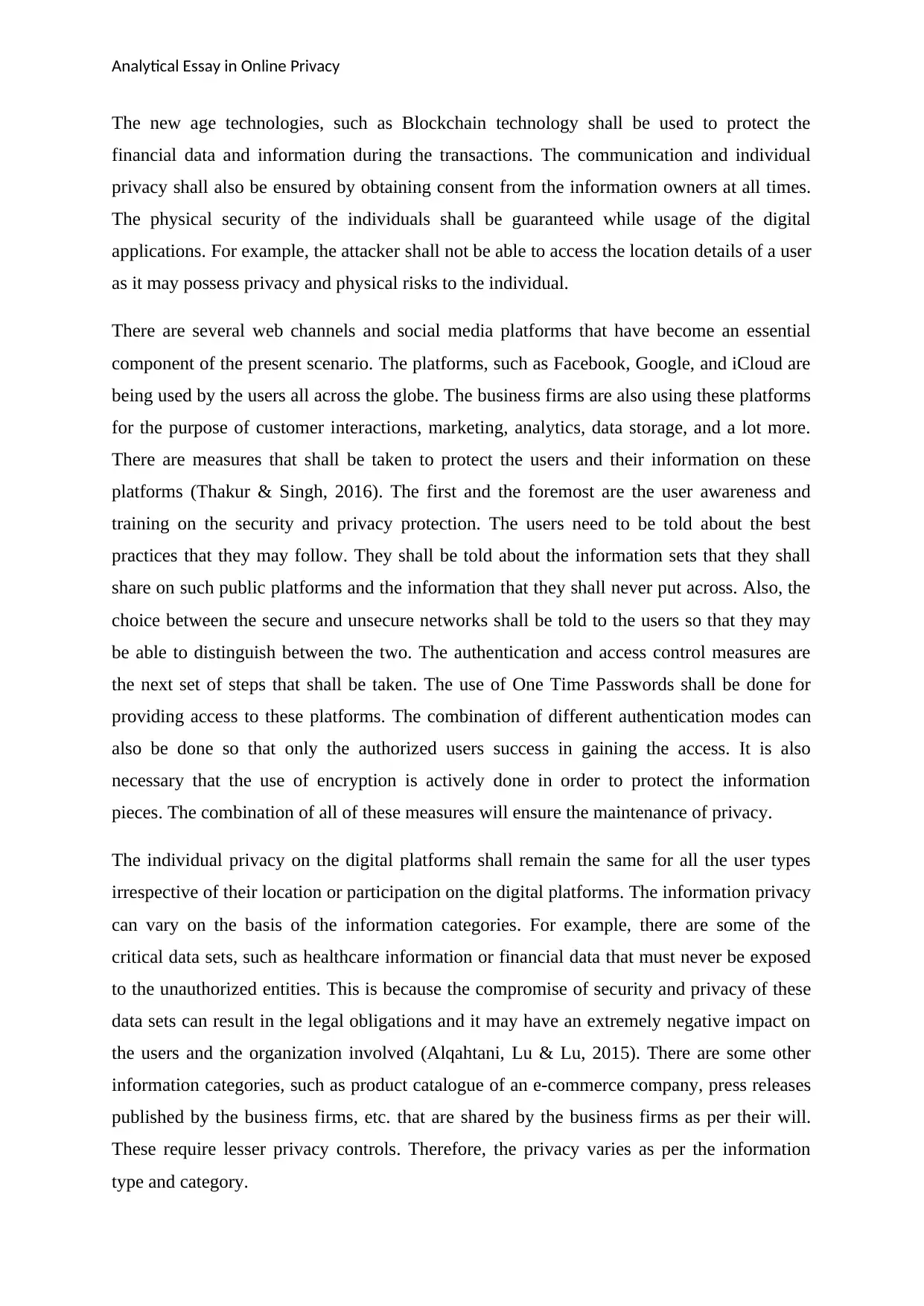
Analytical Essay in Online Privacy
The new age technologies, such as Blockchain technology shall be used to protect the
financial data and information during the transactions. The communication and individual
privacy shall also be ensured by obtaining consent from the information owners at all times.
The physical security of the individuals shall be guaranteed while usage of the digital
applications. For example, the attacker shall not be able to access the location details of a user
as it may possess privacy and physical risks to the individual.
There are several web channels and social media platforms that have become an essential
component of the present scenario. The platforms, such as Facebook, Google, and iCloud are
being used by the users all across the globe. The business firms are also using these platforms
for the purpose of customer interactions, marketing, analytics, data storage, and a lot more.
There are measures that shall be taken to protect the users and their information on these
platforms (Thakur & Singh, 2016). The first and the foremost are the user awareness and
training on the security and privacy protection. The users need to be told about the best
practices that they may follow. They shall be told about the information sets that they shall
share on such public platforms and the information that they shall never put across. Also, the
choice between the secure and unsecure networks shall be told to the users so that they may
be able to distinguish between the two. The authentication and access control measures are
the next set of steps that shall be taken. The use of One Time Passwords shall be done for
providing access to these platforms. The combination of different authentication modes can
also be done so that only the authorized users success in gaining the access. It is also
necessary that the use of encryption is actively done in order to protect the information
pieces. The combination of all of these measures will ensure the maintenance of privacy.
The individual privacy on the digital platforms shall remain the same for all the user types
irrespective of their location or participation on the digital platforms. The information privacy
can vary on the basis of the information categories. For example, there are some of the
critical data sets, such as healthcare information or financial data that must never be exposed
to the unauthorized entities. This is because the compromise of security and privacy of these
data sets can result in the legal obligations and it may have an extremely negative impact on
the users and the organization involved (Alqahtani, Lu & Lu, 2015). There are some other
information categories, such as product catalogue of an e-commerce company, press releases
published by the business firms, etc. that are shared by the business firms as per their will.
These require lesser privacy controls. Therefore, the privacy varies as per the information
type and category.
The new age technologies, such as Blockchain technology shall be used to protect the
financial data and information during the transactions. The communication and individual
privacy shall also be ensured by obtaining consent from the information owners at all times.
The physical security of the individuals shall be guaranteed while usage of the digital
applications. For example, the attacker shall not be able to access the location details of a user
as it may possess privacy and physical risks to the individual.
There are several web channels and social media platforms that have become an essential
component of the present scenario. The platforms, such as Facebook, Google, and iCloud are
being used by the users all across the globe. The business firms are also using these platforms
for the purpose of customer interactions, marketing, analytics, data storage, and a lot more.
There are measures that shall be taken to protect the users and their information on these
platforms (Thakur & Singh, 2016). The first and the foremost are the user awareness and
training on the security and privacy protection. The users need to be told about the best
practices that they may follow. They shall be told about the information sets that they shall
share on such public platforms and the information that they shall never put across. Also, the
choice between the secure and unsecure networks shall be told to the users so that they may
be able to distinguish between the two. The authentication and access control measures are
the next set of steps that shall be taken. The use of One Time Passwords shall be done for
providing access to these platforms. The combination of different authentication modes can
also be done so that only the authorized users success in gaining the access. It is also
necessary that the use of encryption is actively done in order to protect the information
pieces. The combination of all of these measures will ensure the maintenance of privacy.
The individual privacy on the digital platforms shall remain the same for all the user types
irrespective of their location or participation on the digital platforms. The information privacy
can vary on the basis of the information categories. For example, there are some of the
critical data sets, such as healthcare information or financial data that must never be exposed
to the unauthorized entities. This is because the compromise of security and privacy of these
data sets can result in the legal obligations and it may have an extremely negative impact on
the users and the organization involved (Alqahtani, Lu & Lu, 2015). There are some other
information categories, such as product catalogue of an e-commerce company, press releases
published by the business firms, etc. that are shared by the business firms as per their will.
These require lesser privacy controls. Therefore, the privacy varies as per the information
type and category.
⊘ This is a preview!⊘
Do you want full access?
Subscribe today to unlock all pages.

Trusted by 1+ million students worldwide
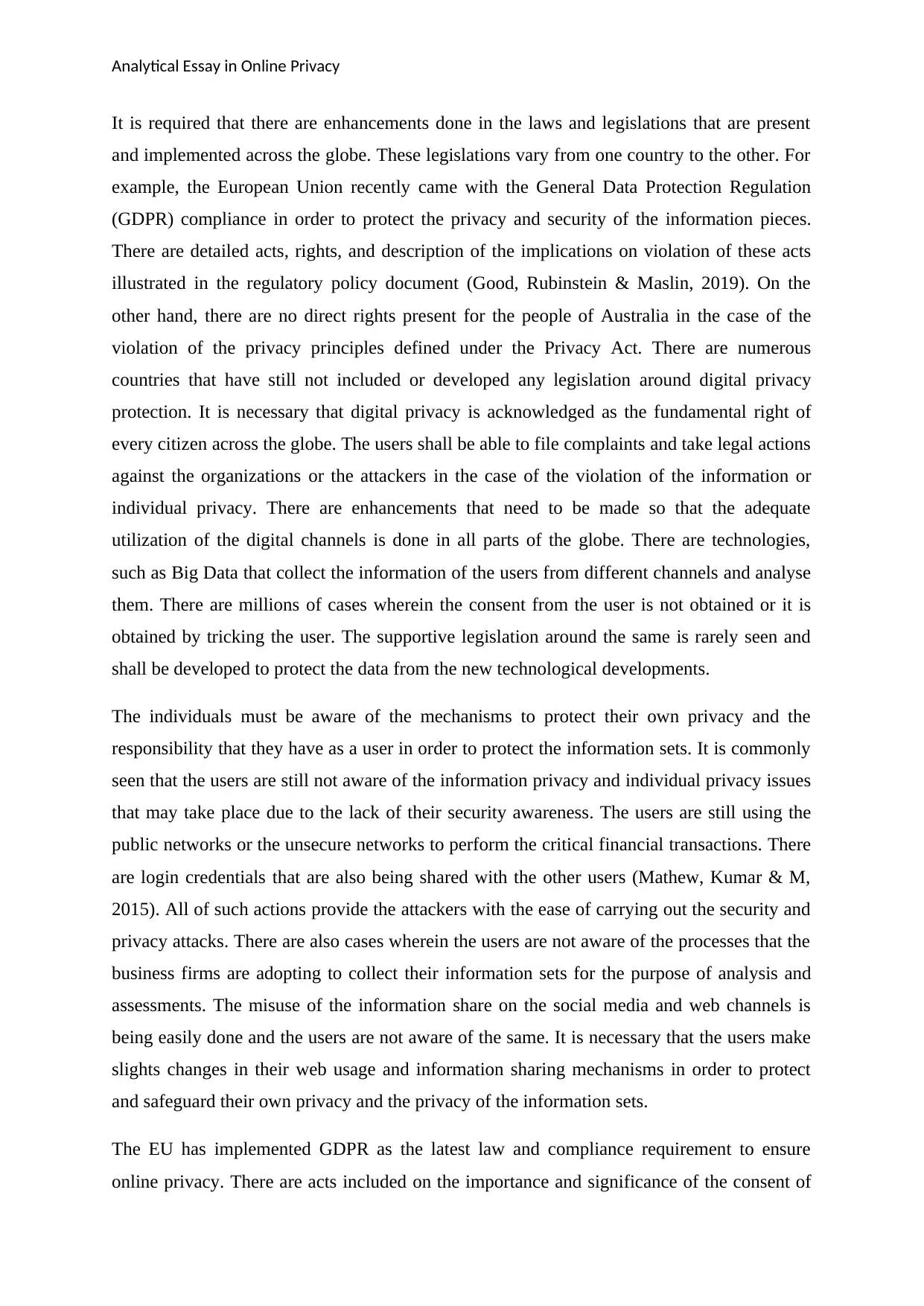
Analytical Essay in Online Privacy
It is required that there are enhancements done in the laws and legislations that are present
and implemented across the globe. These legislations vary from one country to the other. For
example, the European Union recently came with the General Data Protection Regulation
(GDPR) compliance in order to protect the privacy and security of the information pieces.
There are detailed acts, rights, and description of the implications on violation of these acts
illustrated in the regulatory policy document (Good, Rubinstein & Maslin, 2019). On the
other hand, there are no direct rights present for the people of Australia in the case of the
violation of the privacy principles defined under the Privacy Act. There are numerous
countries that have still not included or developed any legislation around digital privacy
protection. It is necessary that digital privacy is acknowledged as the fundamental right of
every citizen across the globe. The users shall be able to file complaints and take legal actions
against the organizations or the attackers in the case of the violation of the information or
individual privacy. There are enhancements that need to be made so that the adequate
utilization of the digital channels is done in all parts of the globe. There are technologies,
such as Big Data that collect the information of the users from different channels and analyse
them. There are millions of cases wherein the consent from the user is not obtained or it is
obtained by tricking the user. The supportive legislation around the same is rarely seen and
shall be developed to protect the data from the new technological developments.
The individuals must be aware of the mechanisms to protect their own privacy and the
responsibility that they have as a user in order to protect the information sets. It is commonly
seen that the users are still not aware of the information privacy and individual privacy issues
that may take place due to the lack of their security awareness. The users are still using the
public networks or the unsecure networks to perform the critical financial transactions. There
are login credentials that are also being shared with the other users (Mathew, Kumar & M,
2015). All of such actions provide the attackers with the ease of carrying out the security and
privacy attacks. There are also cases wherein the users are not aware of the processes that the
business firms are adopting to collect their information sets for the purpose of analysis and
assessments. The misuse of the information share on the social media and web channels is
being easily done and the users are not aware of the same. It is necessary that the users make
slights changes in their web usage and information sharing mechanisms in order to protect
and safeguard their own privacy and the privacy of the information sets.
The EU has implemented GDPR as the latest law and compliance requirement to ensure
online privacy. There are acts included on the importance and significance of the consent of
It is required that there are enhancements done in the laws and legislations that are present
and implemented across the globe. These legislations vary from one country to the other. For
example, the European Union recently came with the General Data Protection Regulation
(GDPR) compliance in order to protect the privacy and security of the information pieces.
There are detailed acts, rights, and description of the implications on violation of these acts
illustrated in the regulatory policy document (Good, Rubinstein & Maslin, 2019). On the
other hand, there are no direct rights present for the people of Australia in the case of the
violation of the privacy principles defined under the Privacy Act. There are numerous
countries that have still not included or developed any legislation around digital privacy
protection. It is necessary that digital privacy is acknowledged as the fundamental right of
every citizen across the globe. The users shall be able to file complaints and take legal actions
against the organizations or the attackers in the case of the violation of the information or
individual privacy. There are enhancements that need to be made so that the adequate
utilization of the digital channels is done in all parts of the globe. There are technologies,
such as Big Data that collect the information of the users from different channels and analyse
them. There are millions of cases wherein the consent from the user is not obtained or it is
obtained by tricking the user. The supportive legislation around the same is rarely seen and
shall be developed to protect the data from the new technological developments.
The individuals must be aware of the mechanisms to protect their own privacy and the
responsibility that they have as a user in order to protect the information sets. It is commonly
seen that the users are still not aware of the information privacy and individual privacy issues
that may take place due to the lack of their security awareness. The users are still using the
public networks or the unsecure networks to perform the critical financial transactions. There
are login credentials that are also being shared with the other users (Mathew, Kumar & M,
2015). All of such actions provide the attackers with the ease of carrying out the security and
privacy attacks. There are also cases wherein the users are not aware of the processes that the
business firms are adopting to collect their information sets for the purpose of analysis and
assessments. The misuse of the information share on the social media and web channels is
being easily done and the users are not aware of the same. It is necessary that the users make
slights changes in their web usage and information sharing mechanisms in order to protect
and safeguard their own privacy and the privacy of the information sets.
The EU has implemented GDPR as the latest law and compliance requirement to ensure
online privacy. There are acts included on the importance and significance of the consent of
Paraphrase This Document
Need a fresh take? Get an instant paraphrase of this document with our AI Paraphraser
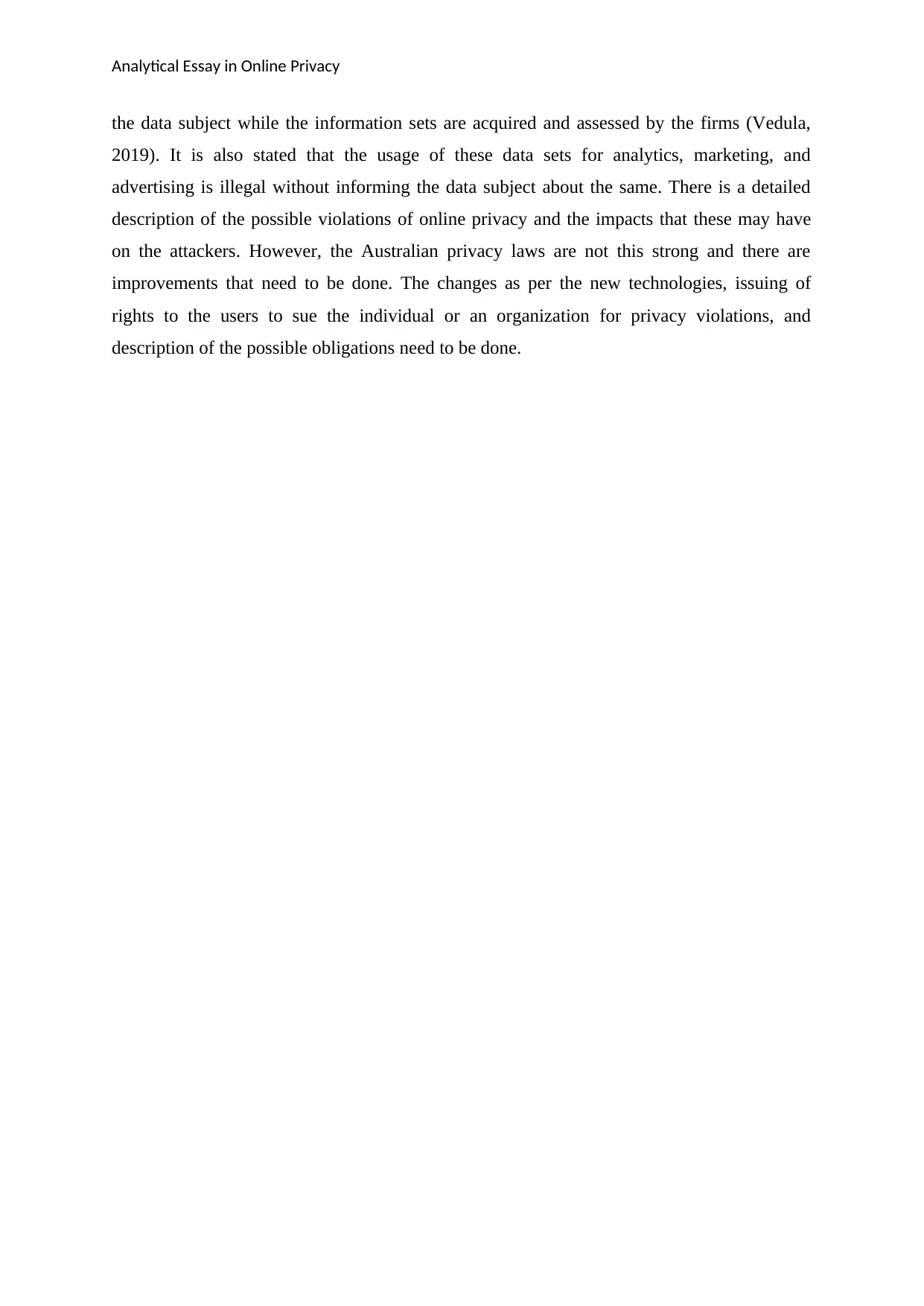
Analytical Essay in Online Privacy
the data subject while the information sets are acquired and assessed by the firms (Vedula,
2019). It is also stated that the usage of these data sets for analytics, marketing, and
advertising is illegal without informing the data subject about the same. There is a detailed
description of the possible violations of online privacy and the impacts that these may have
on the attackers. However, the Australian privacy laws are not this strong and there are
improvements that need to be done. The changes as per the new technologies, issuing of
rights to the users to sue the individual or an organization for privacy violations, and
description of the possible obligations need to be done.
the data subject while the information sets are acquired and assessed by the firms (Vedula,
2019). It is also stated that the usage of these data sets for analytics, marketing, and
advertising is illegal without informing the data subject about the same. There is a detailed
description of the possible violations of online privacy and the impacts that these may have
on the attackers. However, the Australian privacy laws are not this strong and there are
improvements that need to be done. The changes as per the new technologies, issuing of
rights to the users to sue the individual or an organization for privacy violations, and
description of the possible obligations need to be done.
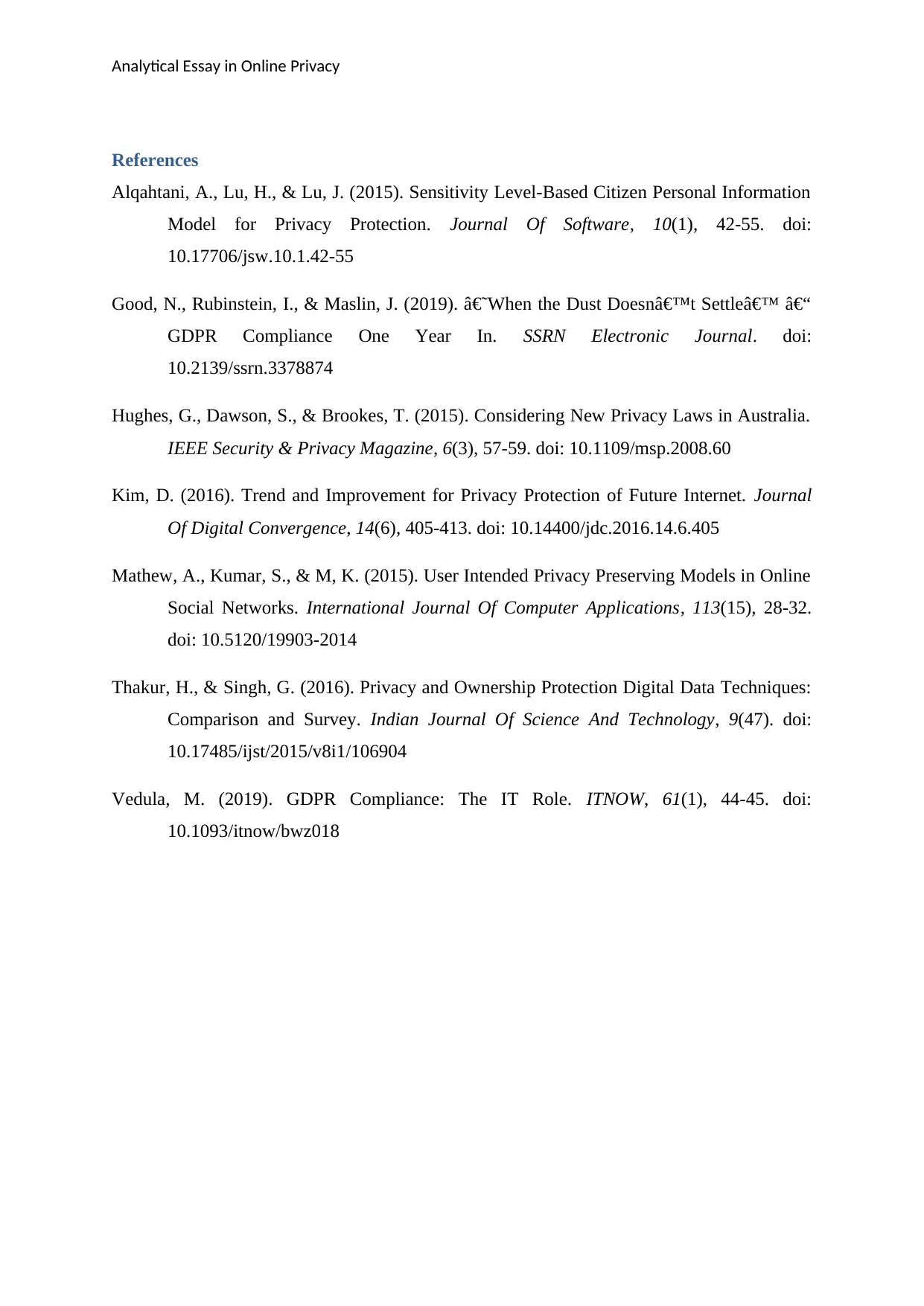
Analytical Essay in Online Privacy
References
Alqahtani, A., Lu, H., & Lu, J. (2015). Sensitivity Level-Based Citizen Personal Information
Model for Privacy Protection. Journal Of Software, 10(1), 42-55. doi:
10.17706/jsw.10.1.42-55
Good, N., Rubinstein, I., & Maslin, J. (2019). ‘When the Dust Doesn’t Settle’ –
GDPR Compliance One Year In. SSRN Electronic Journal. doi:
10.2139/ssrn.3378874
Hughes, G., Dawson, S., & Brookes, T. (2015). Considering New Privacy Laws in Australia.
IEEE Security & Privacy Magazine, 6(3), 57-59. doi: 10.1109/msp.2008.60
Kim, D. (2016). Trend and Improvement for Privacy Protection of Future Internet. Journal
Of Digital Convergence, 14(6), 405-413. doi: 10.14400/jdc.2016.14.6.405
Mathew, A., Kumar, S., & M, K. (2015). User Intended Privacy Preserving Models in Online
Social Networks. International Journal Of Computer Applications, 113(15), 28-32.
doi: 10.5120/19903-2014
Thakur, H., & Singh, G. (2016). Privacy and Ownership Protection Digital Data Techniques:
Comparison and Survey. Indian Journal Of Science And Technology, 9(47). doi:
10.17485/ijst/2015/v8i1/106904
Vedula, M. (2019). GDPR Compliance: The IT Role. ITNOW, 61(1), 44-45. doi:
10.1093/itnow/bwz018
References
Alqahtani, A., Lu, H., & Lu, J. (2015). Sensitivity Level-Based Citizen Personal Information
Model for Privacy Protection. Journal Of Software, 10(1), 42-55. doi:
10.17706/jsw.10.1.42-55
Good, N., Rubinstein, I., & Maslin, J. (2019). ‘When the Dust Doesn’t Settle’ –
GDPR Compliance One Year In. SSRN Electronic Journal. doi:
10.2139/ssrn.3378874
Hughes, G., Dawson, S., & Brookes, T. (2015). Considering New Privacy Laws in Australia.
IEEE Security & Privacy Magazine, 6(3), 57-59. doi: 10.1109/msp.2008.60
Kim, D. (2016). Trend and Improvement for Privacy Protection of Future Internet. Journal
Of Digital Convergence, 14(6), 405-413. doi: 10.14400/jdc.2016.14.6.405
Mathew, A., Kumar, S., & M, K. (2015). User Intended Privacy Preserving Models in Online
Social Networks. International Journal Of Computer Applications, 113(15), 28-32.
doi: 10.5120/19903-2014
Thakur, H., & Singh, G. (2016). Privacy and Ownership Protection Digital Data Techniques:
Comparison and Survey. Indian Journal Of Science And Technology, 9(47). doi:
10.17485/ijst/2015/v8i1/106904
Vedula, M. (2019). GDPR Compliance: The IT Role. ITNOW, 61(1), 44-45. doi:
10.1093/itnow/bwz018
⊘ This is a preview!⊘
Do you want full access?
Subscribe today to unlock all pages.

Trusted by 1+ million students worldwide
1 out of 6
Related Documents
Your All-in-One AI-Powered Toolkit for Academic Success.
+13062052269
info@desklib.com
Available 24*7 on WhatsApp / Email
![[object Object]](/_next/static/media/star-bottom.7253800d.svg)
Unlock your academic potential
Copyright © 2020–2025 A2Z Services. All Rights Reserved. Developed and managed by ZUCOL.





